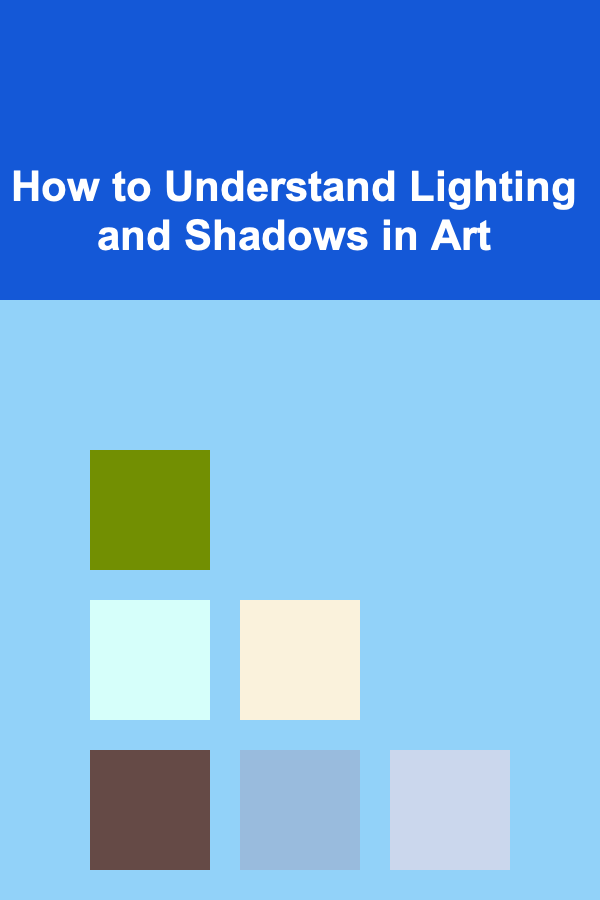
How to Understand Lighting and Shadows in Art
ebook include PDF & Audio bundle (Micro Guide)
$12.99$7.99
Limited Time Offer! Order within the next:

Lighting and shadows are fundamental elements of art that not only help in defining the three-dimensional form of objects but also in creating mood, depth, and drama in a composition. They are essential tools used by artists across different mediums to engage viewers visually and emotionally. Whether in painting, sculpture, photography, or digital art, mastering lighting and shadows can elevate the quality of an artwork, making it more realistic or stylistically impactful. This article delves into the role of lighting and shadows in art, exploring their significance, how they function, and how artists use them to enhance their work.
The Significance of Lighting in Art
The Concept of Light in Art
Light plays a critical role in shaping how we perceive the world around us. In art, light defines not only the visibility of objects but also the nature of the space in which they exist. Light can highlight specific aspects of a subject, guide the viewer's attention, and create various visual effects. In art history, artists have long explored the interplay between light and dark to generate contrasts, emphasize volume, and portray the passage of time.
Types of Light
There are several types of light that artists work with, each of which impacts the artwork differently:
- Natural Light: This light comes from the sun or other natural sources like the moon. It varies in intensity and direction depending on the time of day and weather conditions, giving artists a wide range of lighting effects to work with.
- Artificial Light: Light from man-made sources such as lamps, bulbs, or studio lighting. This type of light is more controllable than natural light, allowing artists to shape the lighting precisely for a specific effect.
- Ambient Light: This is the general light in an environment. It doesn't come from any specific source but provides the overall brightness and atmosphere of a scene.
- Direct Light: Light that shines directly onto an object. It creates harsh contrasts and deep shadows, emphasizing the form and structure of the subject.
- Diffused Light: Light that has been scattered or softened. It reduces the intensity of shadows and creates a more even, gentle light distribution, which is often used to create a calm or peaceful mood.
- Point Light: A light source that emits rays in all directions from a single point. A candle flame or a small bulb can serve as examples. Point lights create sharp shadows and pronounced highlights.
- Spotlight: A concentrated beam of light aimed at a specific area or object, typically used to focus the viewer's attention on that part of the artwork.
The Role of Light in Composition
The choice and manipulation of light affect the composition of an artwork in profound ways. Artists can direct the viewer's attention by placing the light source in a specific location within the artwork. The direction, intensity, and color of light all contribute to how the viewer interacts with the scene.
In classical paintings, artists like Caravaggio used strong contrasts between light and dark (chiaroscuro) to create emotional intensity and highlight the figures of their compositions. In contrast, the soft, even lighting in Impressionist works, such as those by Claude Monet, creates a different sense of atmosphere and feeling, capturing the transient quality of light.
Shadows: The Companion to Light
While light defines the visibility of objects, shadows are equally important in providing context and shaping form. Without shadows, an object might appear flat or disconnected from its environment. Shadows create depth, emphasize the volume of an object, and provide a sense of realism by showing how light interacts with surfaces.
The Nature of Shadows
Shadows are cast when light is blocked by an object. The characteristics of the shadow---its shape, size, and intensity---depend on several factors:
- The Shape of the Object: The shadow mimics the contour of the object blocking the light. A round object casts a soft, rounded shadow, while an angular object will create sharper, more defined shadows.
- The Angle of Light: The direction and angle of the light source determine where and how shadows fall. A light source positioned above will cast shadows downward, while a side light will create elongated shadows to the opposite direction.
- The Distance from the Light Source: The closer the light source is to the object, the more defined the shadow will be. Conversely, if the light source is distant, the shadow will be softer and more diffused.
- The Intensity of the Light: Bright light creates strong, well-defined shadows, while softer light results in faint or diffused shadows. The contrast between light and shadow gives shape to the object, making it appear three-dimensional.
Types of Shadows
There are three main types of shadows that artists can incorporate into their work:
- Cast Shadows: These are the shadows cast by an object onto a surface when the light is blocked. Cast shadows are the most obvious and dramatic, as they often contribute to the depth of a scene.
- Form Shadows: These are the shadows that occur on the object itself. They result from the light falling on different surfaces of the object, with some parts illuminated more than others. Form shadows help to define the volume and three-dimensionality of the object.
- Core Shadows: These are the darkest areas of a form shadow, typically found on the side of the object farthest from the light source. Core shadows are essential for artists to create the illusion of depth and dimension.
Chiaroscuro: The Play of Light and Shadow
One of the most powerful techniques for understanding the relationship between light and shadow in art is chiaroscuro, an Italian term meaning "light-dark." This technique refers to the use of stark contrasts between light and dark to model forms and create dramatic effects.
The Origins of Chiaroscuro
Chiaroscuro first gained prominence during the Renaissance, with artists such as Leonardo da Vinci and Caravaggio pushing the boundaries of this technique. By dramatically contrasting light and dark, artists could create depth and volume in two-dimensional works, making them appear three-dimensional. Caravaggio, in particular, was known for his masterful use of chiaroscuro to convey realism and psychological intensity in his religious and genre paintings.
The Effect of Chiaroscuro on Composition
Chiaroscuro can direct the viewer's gaze toward specific areas of the composition, heightening the drama and emotional impact. For example, in Caravaggio's "The Calling of Saint Matthew," the intense light falling on the figures sharply contrasts with the surrounding darkness, directing attention to the central action in the painting and emphasizing the moment of divine intervention.
Chiaroscuro can also evoke mood and atmosphere. High-contrast lighting can create a sense of tension, mystery, or foreboding, while softer light can suggest calmness, serenity, or intimacy. The manipulation of light and shadow, then, is a powerful tool for setting the emotional tone of the artwork.
The Role of Shadows in Stylized Art
While realistic depictions of light and shadow can add depth and volume to a piece, shadows are also a key element in stylized or symbolic art. In some artistic traditions, shadows are used not only to suggest form but to represent abstract ideas or cultural symbols.
For example, in Japanese ink painting (sumi-e), shadows are often soft and minimal, serving more as a suggestion of form rather than a realistic depiction. In this tradition, the artist may emphasize the play of light and shadow to create a sense of tranquility or spiritual enlightenment.
In Surrealism, artists like Salvador Dalí employed exaggerated shadows to create dreamlike, often unsettling images. Dalí's shadows were sometimes so discordant that they seemed to defy the laws of physics, adding to the otherworldly quality of his works.
Lighting in Different Mediums
Artists work with different mediums that affect how they manipulate lighting and shadows. Understanding how light behaves in these various contexts is essential to producing the desired effect.
In Painting
In painting, artists use a variety of techniques to simulate light and shadow. The use of glazing (layers of transparent paint) allows for a gradual build-up of light and shadow, giving depth to the painted surface. Scumbling (a dry brushing technique) can be used to create a softer transition between light and shadow.
For instance, in oil painting, light can be modeled by applying highlights with thick layers of paint, or by leaving areas of the canvas bare to allow the white of the canvas to reflect light.
In Sculpture
Sculptors work directly with light and shadow by shaping three-dimensional forms that interact with the environment. The play of light on the curves and angles of a sculpture gives the piece its volume and structure. Artists often use shadows to create tension or highlight particular aspects of a sculpture, such as the texture or surface detail.
In classical sculpture, the ideal of the "contrapposto" stance (a pose where the body is slightly twisted) is often emphasized by the lighting and shadows that define the muscles and contours of the figure.
In Photography
Photographers manipulate light and shadows using studio lighting setups, natural light, or even digital filters. A strong light source may create high contrast, while diffused light can reduce the harshness of shadows. Photographers can also use shadows as compositional tools, framing the subject or adding interest to an image. For example, the long shadows of the setting sun can create dramatic effects, while the interplay of light and shadow in black-and-white photography can enhance texture and form.
In Digital Art
Digital artists can precisely control the intensity, direction, and softness of light using software tools. The use of lighting effects in digital art has evolved, with techniques such as ambient occlusion and global illumination adding realism. Digital artists can simulate real-world lighting conditions or experiment with entirely new lighting systems, expanding the possibilities of light and shadow.
Conclusion
Lighting and shadows are powerful artistic tools that influence the perception, emotion, and narrative of an artwork. Through careful manipulation of light and shadow, artists can create the illusion of depth, texture, and volume. They can also use light and shadow to guide the viewer's eye, create mood, and evoke specific emotional responses. Whether in painting, sculpture, photography, or digital art, understanding the interplay between light and shadow is essential for artists who seek to master their craft and create impactful works. By learning how to control and manipulate these elements, artists can transform their works, elevating them from mere representations of reality to compelling, dynamic expressions of artistic vision.

How to Create a Family Vision Board Together
Read More
How to Maintain Your Roof for Longevity
Read More
How to Manage Your Finances as a Freelancer or Entrepreneur
Read More
How to Plan for Renovations Without Disrupting Tenants
Read More
Why Clear Surfaces Lead to a More Peaceful Home
Read More
Maintaining Your Digital Kitchen Scale for Accuracy: A Comprehensive Guide
Read MoreOther Products

How to Create a Family Vision Board Together
Read More
How to Maintain Your Roof for Longevity
Read More
How to Manage Your Finances as a Freelancer or Entrepreneur
Read More
How to Plan for Renovations Without Disrupting Tenants
Read More
Why Clear Surfaces Lead to a More Peaceful Home
Read More